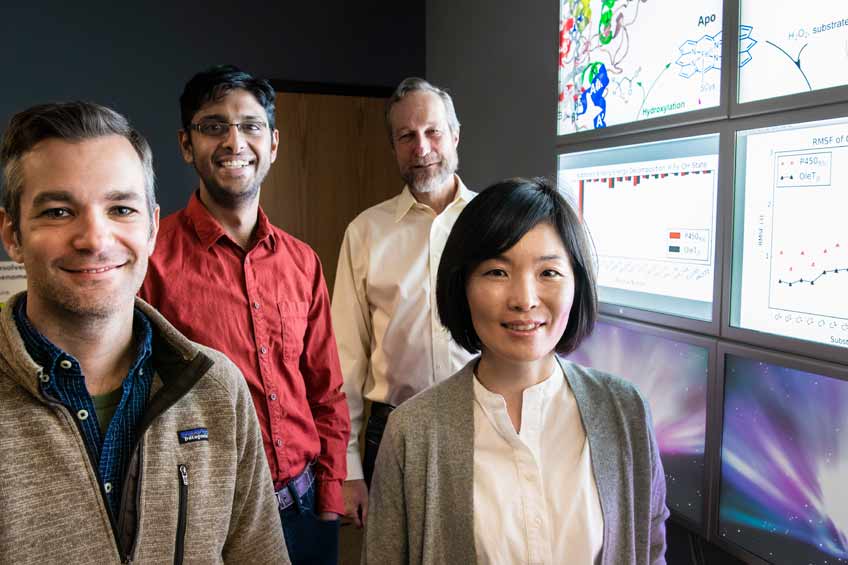Molecular Scientists Unlock Sustainable Route Toward Hydrocarbons
A computational modeling team in NREL’s Biosciences Center made a significant discovery regarding the key aspects of a cytochrome P450 enzyme that enable it to transform fatty acids directly to olefinic hydrocarbons, an important constituent of gasoline. Understanding how enzymes bring about this biochemical transformation can lead to unlocking a sustainable route to fuel production and is critical to NREL's efforts to develop transportation fuels for the future.

Michael Guarnieri, Vivek Bharadwaj, Michael Crowley, and Seonah Kim co-authored the paper, "Different Behaviors of a Substrate in P450 Decarboxylase and Hydroxylase Reveal Reactivity-Enabling Actors," which has been published in Scientific Reports. Photo by Dennis Schroeder, NREL
To Decarboxylate or Hydroxylate
Published in Scientific Reports, "Different Behaviors of a Substrate in P450 Decarboxylase and Hydroxylase Reveal Reactivity-Enabling Actors" focuses on two cytochrome P450 enzymes that share similarities in terms of structure, substrate scope, and mechanism but bring about contrasting chemical transformations. While OleTJE is a decarboxylase enzyme that converts fatty acids to alkene hydrocarbons by removing oxygens from the molecules, P450BSβ is a hydroxylase that converts fatty acids to hydroxylated fatty acids and thus adds yet more oxygen to the molecules. Decarboxylation is a preferred enzymatic reaction for converting biomass feeds into hydrocarbon fuels.
Scientists on NREL's computational modeling team unraveled the key behaviors that make the OleTJE enzyme more likely to decarboxylate and the P450BSβ enzyme more likely to hydroxylate. The study sought to understand the basis for the decarboxylation reaction by modeling the same fatty acid substrate in both OleTJE and P450BSβ at the molecular level and then compared and contrasted the enzyme and substrate characteristics that resulted in their preferred reactions.
"The current biofuels industry is dominated by oxygenated fuels such as ethanol. The oxygen in ethanol affects its performance as a fuel and hence is unlikely to completely replace current fossil fuels that are mostly hydrocarbons with no oxygen," said Vivek Bharadwaj, a computational molecular scientist at NREL and the lead author of the paper. "However, if we can improve the performance of OleTJE to produce more olefins compared to hydroxy-fatty acids, we can renewably produce fuels that are chemically indistinguishable from their fossil fuel counterparts."
Preventing Substrate Rebound
Previous studies have revealed that hydroxylation is enabled by "substrate rebound" at the active site, which requires the fatty acid substrate—the substance on which the enzyme acts—to be flexible at the active site. For an enzymatic reaction to flow toward hydrocarbons, the substrate needed to be more stable or tightly bound in its position to avoid the rebound mechanism. While other studies have hypothesized that the substrate mobility plays a role in the mechanism, this NREL study is the first to corroborate the hypothesis and unravel important molecular level factors that facilitate the decarboxylation reaction to produce hydrocarbons.
NREL scientists identified three key factors that drive decarboxylation in OleTJE.
- OleTJE can better stabilize the substrate tail with increased amino-acid residue interactions in the substrate binding pocket.
- When compared to P450BSβ the substrate in OleTJE had stronger hydrogen bonding with an important Arginine residue at the active site. This demonstrated the importance of active site arginine in not only limiting substrate mobility in OleTJE but also suggested an increased capacity to decarboxylate the substrate.
- Modeling showed that the region surrounding the heme oxygen atom is characterized by greater water occupancy in OleTJE as compared to P450BSβ. While water molecules are known to play a functional role in cytochrome P450s, these simulations reveal that the presence of excess water at the active site restricts movement and enables decarboxylation by discouraging substrate rebound.
Direct Path to Drop-In Fuels
The insights garnered from this study will provide a roadmap for future enzyme engineering strategies to improve OleTJE performance. These strategies will likely involve controlling substrate mobility at the active site and impact it by controlling water occupancies and substrate stabilizing enzyme interactions.
"The OleTJE enzyme offers us the unique capability of directly producing drop-in fuels from fatty acids that are ubiquitously produced by all microorganisms. Understanding the behaviors of this enzyme at a molecular level has great potential to make the process of converting biomass into advanced biofuels more efficient by using fewer unit operations," said Michael Crowley, group manager of computational science at NREL and corresponding author of the study. "If future engineers can tune the OleTJE fatty acid enzyme to produce more hydrocarbons, this would be a significant contribution to our efforts for a sustainable future with renewable fuels."

